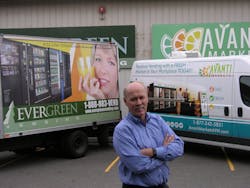Seattle Visionary Ushers In New Vending Era With Micro Markets
When Jim Brinton, president of Evergreen Vending, felt the impact of the 2008-2009 Great Recession, he was concerned. His 34-year-old vending operation based in Seattle, WA, was weathering the turbulent economic times, but the future didn’t look as bright as the past. His concern deepened as he visited other vending operators around the U.S. in the capacity of NAMA Chairman. “I was feeling the same pain as the operators I was seeing across the country,” he said. With businesses closing or reducing employees, vending locations were disappearing. Wage freezes or reductions were leading to significant decreases in revenue. With no major changes to the vending industry since glass front vending machines and the bill validator, operators found it hard to highlight their service versus their competitor and drive the higher prices they needed to maintain profitability. Many saw a bleak future. However, visionaries see things differently. That is why, despite this time of uncertainty, Brinton decided to launch into a new enterprise that would not only reinvigorate his operation, but the entire industry — micro markets.
Micro markets were a much needed solution to Brinton’s concerns thanks to their ability to attract customers willing to pay higher prices for a greater variety of food as well as meet demands of an increased number of larger locations. In addition, the recovering post-recession economy made it an even more promising time to launch a new workplace refreshment segment.
“I often say the stars aligned,” joked Brinton about how he got into the micro market business. And he also credits it for keeping him in the industry. “I might not be here — my company that is — without micro markets,” Brinton added seriously.
The job he always returned to
Brinton began his vending career in 1976, at age 17. He installed a vending machine in his father’s auto supply store because employees kept enjoying his soda without paying him for it. Once he had one machine, he started looking for other places he could install the venders. When Brinton left for college he turned the business over to his younger brother to run for him. “It wasn’t his passion,” explained Brinton, who had to return to run the company. He grew his business by 250 percent in the next year, organically and by buying a few routes from other operators. Then in 1985, still young and full of too much energy, Brinton decided to also pursue a career in law enforcement with the City of Seattle after the encouragement of some friends. After 10 years, the unpredictability of the job led him back to vending full time. Since then, Evergreen Vending has grown to include 54 routes and 165 employees operating from four different locations throughout Western Washington and Oregon.
An industry is born
After the challenges of the recession, Brinton knew his company’s future had to be different. Probably the biggest change he made, both for his company and the industry, was going into business with another operator on a self-checkout system that did not use RFID tags, but allowed users to scan the existing bar codes on products. Up until that point, the systems marketed to the industry had needed RFID tags affixed to each product which added labor and physical label costs. Brinton thought there had to be another way and placed a few kiosks in locations for testing in 2009.
“I looked at the results of the base test and thought ‘this might be the savior of my business’,” said Brinton. In 2010, Brinton hired sales people for his micro market division and started adding two to three markets per week. He now has 600 markets over his service area from greater Seattle, WA to central Oregon and in between operating the same as other operations. “There are no back doors here,” he joked about his employees using the same systems, reports and technical support number as the rest of the country including paying the same service fees as everyone else.
As time went on, the revenue numbers truly put in perspective for Brinton the importance of diversifying his operation. “It took me 35 years to develop 30 percent of my business revenue [vending, OCS and used equipment] and only 5 years to develop 70 percent — micro market sales,” explained Brinton. Despite being a smaller percentage, he hasn’t seen vending shrink that much. There is some attrition when adding micro markets, but most of his micro markets were and continue to be new workplaces that did not have vending or transitioned from operators who did not endorse the micro market concept early on.
“In the past, work environments have shut out vending, but were not big enough for a cafeteria,” said Brinton. Evergreen Vending was able to meet the needs of these customers by offering micro markets under Avanti Markets Northwest. Brinton continues to add about 150 micro markets a year.
Location land grab
Brinton first went after locations he felt were low hanging fruit. They either weren’t being serviced at all or adequately served by vending. The type of workers, blue collar versus white collar, was not one of his main considerations as he had seen the micro market concept work with multiple types of locations. The number of employees and existing service were the main drivers.
Brinton believes that right now is an important time for the micro market division of his company, and likely the industry. “It’s a real estate grab,” he said, “in any area of the country.” He believes it’s important for the vending industry to establish itself as the leader in this segment so outside competition does not enter the marketplace. He is getting workplaces ideal for micro markets under contract, even if it means routes that are less dense than they could be. He feels he can back fill, or add more micro market locations to existing routes in the future. He has also been converting some of his vending customers to micro markets. It offers them a different experience, the potential to increase his sales, but also to reestablish his relationship with the location.
The commission reset
Converting an existing Evergreen Vending account to an Avanti Northwest micro market served to reset customers used to shopping for breakroom services based on price or getting commissions. “We used it as an opportunity to set different expectations for the customer and profit model,” explained Brinton. His team focuses on how micro markets bring a service to the location — better refreshing staff on site. Sales is able to explain that micro markets run differently, aren’t vending, and do not pay commissions. Products are different, with more variety than vending. This keeps customers from trying to make a price comparison. Usually, the micro market concept is so inviting they don’t mind giving up commissions.
A redesigned warehouse
The warehouse in the headquarters of Evergreen Vending and Avanti Markets Northwest looks more like a members-only warehouse club. There are large, glass fronted coolers so warehouse staff can pick food while being at a normal temperature. This is especially important for Brinton’s growing micro market operation as 32 percent of his product is food — refrigerated or frozen. In fact, his food demand has gotten so high, he has started an unconventional process. He uses the Seattle warehouse for food and his Olympia, WA, warehouse 65 miles away for dry goods, which constitute about 70 percent of the micro market product volume. Each night, prekitted food is driven down to Olympia and prekitted dry goods are sent back on the truck to Seattle to be loaded onto vehicles and ultimately distributed to micro markets.
Having to reestablish the logistics of product delivery has also caused Brinton to consider how he uses vehicles. He has a fleet of hybrid vehicles for sales and service technicians to use. For micro market deliveries, he has begun switching to the RAM ProMaster with a custom interior. Food is arranged on top above beverages as food is lighter. There is also a refrigerated compartment that runs on 12 volts so there is no extra compressor needed. “This is the easiest and best layout,” said Brinton. He still has more traditional delivery vehicles, but is moving away from them in favor of the gas savings of the newer vans. With such an extensive fleet of over 80 vehicles total, Brinton employs vehicle maintenance staff to service them onsite. He also has outdoor outlets for the vehicles to be plugged in to power the refrigerator.
The new vehicles work because Brinton is no longer operating a warehouse on wheels where vehicles would hold 60 to 80 items per truck. Micro markets offer 350 items. “There is no way to be a rolling warehouse and serve micro markets,” explained Brinton. “You can’t effectively run markets without prekitting,” he added, glad it was a system that already existed in the industry.
The value proposition of food
With micro markets, food has become a central and profitable aspect to the business. That wasn’t the case with vending food. “We weren’t making money on fresh food,” he said about the days he just served food from vending machines. Micro markets are different, so the food has to be different, too. “What I realized was that vending food was a last resort. But micro markets have created a meal stop,” said Brinton. Why? Because now employees aren’t burning gas, losing their parking spot, fighting traffic or wasting breaks commuting for food and beverages. That includes the time it takes to get focused once again on the work the employee was doing. “That is the value proposition that has replaced commissions,” added Brinton.
With this value proposition comes some responsibility for the operator. The micro market food program must stay fresh and new. “A successful micro market food program means offering unique items and having the control to change the menu and increase the quality of the ingredients so the food remains unique,” said Brinton. He changes his food often, but does not run his own commissary.
Promotions are a key driver
Brinton has also noticed that merchandising and marketing in micro markets is necessary. A new market might boost sales initially, but to keep the momentum up, the operator must run promotions and new products. Avanti Northwest bundles products together for deals or runs ‘buy X number of the item and get one free’ deals. It pushes advertising and promotions via the kiosk and mobile. Micro market coolers are refaced to look new and market layouts are rearranged so users need to “hunt” to find the products they want. New products are introduced regularly, either by customer request or because of manufacturer promotions. “It’s much more like retail,” said Brinton. “And very different than in vending.” The company is even experimenting with take home options, like holiday cookie tins, as last minute gift options for a neighbor.
One of the indispensable tools Brinton uses in micro market merchandising is food tasting. He partners with manufacturers for free or discounted product as well as collecting a fee to pay for the event. He then has a dedicated staff member visit different markets Tuesday, Wednesday and Thursday each week to hand out samples of that product. Brinton says it works to increase sales of the sampled item, but also to reenergize the market. It’s a technique he believes any operator could do. “Brokers and manufacturers have a budget for this and love it,” Brinton said. It’s a scalable idea for any number of markets. For example, he suggests that if an operator had 26 markets, they could do one every other week.
Other branches of service
Brinton does offer coffee service, called NW Coffee Service, but it’s a small revenue segment for his company. “OCS is not a huge push because this is a very competitive market with lots of quality coffee and strong brand names,” said Brinton. In micro markets, Brinton usually offers a single-cup brewer to meet the gourmet tastes of his clientele. In locations where time is an issue, Avanti Northwest installs multiple brewers rather than liquid coffee or a vended coffee. “If it’s coming from a vending machine [or pre-made], it has a connotation for the client,” said Brinton. “It’s all about perception, especially in the Northwest where there’s a focus on healthy, organic and fresh.”
In addition to OCS, Brinton has also opened a distribution company for used vending equipment. “It was something I started 15 years ago under the name Vending Equipment Center as an outlet to dispose of used equipment that still operated,” he said. It is located in Kent, WA. It also offers installation service and repair services to both Evergreen and other area operators.
While these other segments make up a substantial portion of Brinton’s operations, micro market service has become his lead. He considers vending a mature industry. “If they want to talk to you about vending, they’ve heard it all. Micro markets spark their interest,” said Brinton. And it has been doing very well for the veteran operator. In locations that he has converted from vending, he sees two times the sales, on average. “I look at that and think ‘long term that means I can do half as many locations for the same amount of money’,” said Brinton. He has had sales people return to his company because they want to be a part of this new, invigorating industry. The increase in products sold in micro markets more than makes up for incidentals like shrinkage according to Brinton. “My shrinkage is at 1.5 percent,” he said. “Besides, I’m in the business to sell product, so how do I get a higher sale volume in a location? With a micro market.”
Vending has strong future
Despite the growth in other areas, Brinton believes vending will be important in the short and long term future of breakroom refreshment service. “Certain locations will never have a micro market — and vending is perfect,” he said. In fact, he has used knowledge gained from micro markets to improve his vending operations. Evergreen Vending is now headed to a cashless future.
In 2009, Brinton didn’t have many credit and debit card readers on his vending machines. As he began using micro markets, he noticed that 70 percent of the transactions were cashless and that number opened his eyes. “How could I not have debit/credit cards on vending?” he asked. This year 55 percent of his machines accept cashless payment and he’s still deploying. “We plan to go 100 percent,” he said. “Cashless payment acceptance on vending has probably been the most valuable lesson I’ve learned so far.” From his experience, Brinton also believes promotions available at vending machines, like the USConnect program, will give that segment a boost.
The future is bright for Brinton’s vending, micro market and office coffee operation. “I have a reason to come to work again,” he joked. Brinton believes micro markets will contribute the most to his operation’s overall sales growth in the coming years.
The fee tradeoff
While Brinton is also the president of Avanti Markets Corporate, the nationwide supplier of Avanti micro markets, the micro market side of his operation has the same profitability model as any operator. “My staff call the same support line number and I still pay service fees,” said Brinton.
Ongoing service fees are a hurdle Brinton hears from many operators. He believes that they are comparable to some of the fees in vending that get overlooked because operators are so used to them.
“First, vending machine credit card fees are higher than micro markets,” indicated Brinton. Also, taxes are more transparent for the customer, saving some money per transaction. For example, in Washington there is a high sales tax, which needs to be added into the price of vending items while balancing the price point customers will actually pay. In Oregon there is a bottle deposit that must be paid. In micro markets, both those taxes are added in at the kiosk, just like other retail environments, so the price of the product doesn’t have to be adjusted. Add to this the cost of vending management systems, service calls, as well as cash shortages or product spoilage for vending machines compared to micro markets, and the money is pretty comparable in Brinton’s estimation. Commissions are another large cost area for vending that is eliminated (or should be eliminated) with micro markets, according to Brinton.
How a changing world accelerated the growth of micro markets
Jim Brinton, president of Evergreen Vending and Avanti Markets Northwest as well as one of the founders of Avanti Markets, saw the potential of a self-checkout system early on. However, he was also aware that if the
world had not evolved, the idea would not have worked.
In 2004, there were very few self-checkout systems the average person saw and used on a regular basis “If that had continued to be the case, introducing one at the workplace would have been foreign to customers,” Brinton said, and he suggests that micro markets might not have even worked. Luckily now there are self checkout systems everywhere from airports to big box stores.
Another push towards micro markets came with consumers. At the same time that self-checkout systems became more mainstream, there was a generational shift in consumers and how they preferred to shop. “Millennials prefer a non-human touch transaction,” said Brinton. “It has made micro markets a much easier sell.” Even the move to a better-for-you product selection including fresh food, diet drinks or gluten-free products has contributed to the success of the micro market segment. “I think we’ve made a lasting impression on our customers,” said Brinton. He doesn’t see micro markets going anywhere but up.
Operation Profile
Founded: 1976
Owner: Jim Brinton
Headquarters: Seattle, WA
Routes: 24 vending,
4 coffee, 26 micro market
Single cup lines: iCups,
Total 1, Wolfgang Puck
VMS: Crane Streamware
Cashless provider:
Crane Navigator
Warehouse system:
Lightspeed mobile
Micro market provider: Avanti

Emily Refermat | Editor
Emily has been living and breathing the vending industry since 2006 and became Editor in 2012. Usually Emily tries the new salted snack in the vending machine, unless she’s on deadline – then it’s a Snickers.
Feel free to reach Emily via email here or follow her on Twitter @VMW_Refermat.







